Replaces
1999 Chevrolet S10 Pickup 4 Wheel Drive Front 14 Piece Steering, Suspension, & Drivetrain Kit TRQ PSA63518
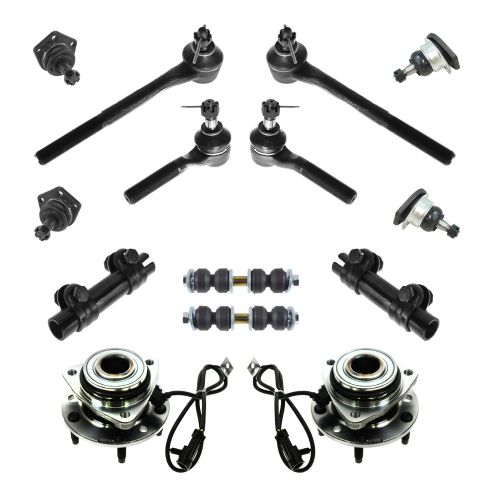


PSA63518
In Stock
This part doesn’t fit a . Select from parts that fit.
Specify your vehicle's year, make and model to guarantee fit.
Orders must be placed by 2pm ET

You may also like
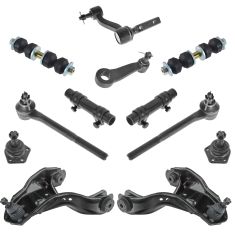
12 Piece Steering & Suspension Kit
$179.95
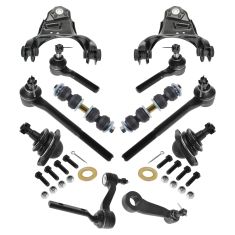
12 Piece Steering & Suspension Kit
$179.95
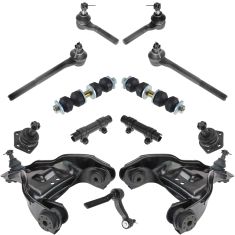
13 Piece Steering & Suspension Kit
$184.95
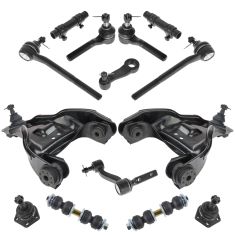
14 Piece Steering & Suspension Kit
$189.95
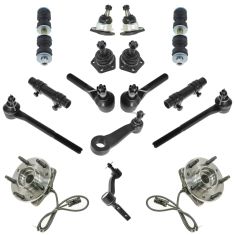
16 Piece Steering, Suspension, & Drivetrain Kit
$204.95
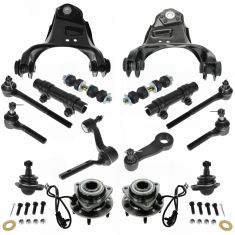
16 Piece Steering, Suspension, & Drivetrain Kit
$279.95
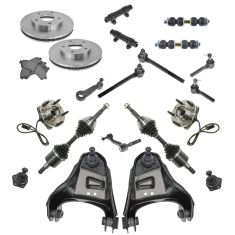
Ceramic 21 Piece Steering, Suspension, & Brake Kit
$489.95
Part Details
- Bearing Type: Ball Bearing
- Quantity: 14 Piece
-
Kit Includes:
(2) Front Sway Bar Links
(2) Front Lower Ball Joints
(2) Front Outer Tie Rods
(2) Front Upper Ball Joints
(2) Front Inner Tie Rods
(2) Front Tie Rod Adjusting Sleeves
(2) Front Wheel Bearing & Hub Assemblies
Specification
- 4 Wheel Drive
- Front
Product Features
TRQ drivetrain kits are manufactured using premium raw materials to restore original performance. Each TRQ drivetrain component is designed to be a direct, maintenance-free replacement to the stock unit. To extend the service life of your drivetrain, TRQ recommends replacing wheel hubs, bearings, and constant velocity (CV) drive axles at the same time to ensure even wear of components and improved ride comfort. All products are fit and road-tested in our Massachusetts R&D facility to ensure we deliver on our promise of Trusted Reliable Quality.
Install Tip: When replacing steering components, have a professional alignment performed afterwards. This ensures proper tracking and even tire wear.
Our steering and suspension components are pre-greased and sealed for long life and do not require the extra maintenance typically required by greaseable versions.
Item Condition:
New
Attention California Customers:
![]() WARNING: This product can expose you to chemicals including Lead and Lead Compounds, which are known to the State of California to cause cancer, and birth defects or other reproductive harm. For more information, go to www.P65Warnings.ca.gov.
WARNING: This product can expose you to chemicals including Lead and Lead Compounds, which are known to the State of California to cause cancer, and birth defects or other reproductive harm. For more information, go to www.P65Warnings.ca.gov.
Lifetime Warranty
This item is backed by our limited lifetime warranty. In the event that this item should fail due to manufacturing defects during intended use, we will replace the part free of charge. This warranty covers the cost of the part only.
FREE Shipping is standard on orders shipped to the lower 48 States (Contiguous United States). Standard shipping charges apply to Hawaii and Alaska.
Shipping is not available to a P.O. Box, APO/FPO/DPO addresses, US Territories, or Canada for this item.
Expedited is available on checkout to the United States, excluding Alaska, Hawaii.
Final shipping costs are available at checkout.





Created on:
Tools used
- Before lifting the car, loosen the lug nuts up with a 19 mm wrench, and the hub nut using a 35 mm socket. It's best to do this while the car is on the ground so the wheels won't move.
- Position the jack under the control arm with a jack stand under the frame. Raise the car (most of the weight should be on the jack stand).
- Remove the tire, and the hub nut and washer. To remove the break caliper, there are two 18 mm bolts to remove-one on top and one on the lower backside. Once those are off, pry the caliper right off with the wrench. Remove the brake rotor.
- Now, to redistribute the weight, move the jack out to the end of the control arm, and jack it up so that most of the weight in now on the jack with only a little weight on the jack stand.
- First, disconnect the harness. Remove the clips on the left side of the harness, and use a screwdriver to pry it up off the frame. It would be best to coat the nuts with penetrating oil at this time. Take the small bolt off with the 10 mm wrench (put the bolt and the nut back into the control arm just for safe keeping so you'll know where they are). Remove the last bolt on the frame-a 13 mm bolt. Once the bolts are removed, pull the harness out and free. (Save the clips from the harness in case you need them to install)
- There's three 18 mm bolts that hold the hub-one in the back, one in the middle of the top, and one in the front. The front and rear ones can be reached with an impact wrench or regular wrench. The middle one, you'll need to use a hand wrench. (Swivel the steering to help you get at the bolt easier.) Remove all three bolts. Using the pry bar or screwdriver, pry against the steering knuckle. (Be careful not to bend up that backing plate too much.) Pull out and away from the backing plate, and the hub is out. (There is a little O ring that needs to be replaced correctly. If you are replacing the hub, transfer it to the new hub. If not, make sure it's in the correct spot.)
- There are two bolts where the ball joint is secured to the control arm. (If your ball joint hasn't been replaced before, you'll just see little round rivets.) If it is rivets, use a cold chisel and pound them to shear them right off. Remove these bolts or rivets on the front, in the back and underneath.
- Remove the cotter pin and the bolt-22 mm or 24 mm-from the ball joint. Remove the cotter pin and the bolt-18 mm or 19 mm-from the tire rod end. For the tire rod end, hit it with a couple of good hammer hits. Holding the control arm, give the ball joint a few whacks as well. Take out all the bolts from the top of the ball joint. Pull down on the control arm and towards the rear of the vehicle, and the ball joint will come out.
This video is brought to you by 1AAuto.com your source for quality replacement parts and the best service on the internet.
Hi I'm Mike Green. I'm one of the owners of 1A Auto. I want to help you save time and money repairing and maintaining your vehicle. I'm going to use my 20 plus years experience restoring cars and trucks, to show you the correct way to install parts from 1A Auto.com. The right parts, installed correctly, are going to save you time and money. Thank you and enjoy the video.
In this video we'll be showing you how to remove a ball joint from this S-10 pickup, same as any pickup truck or Blazer. This is just the removal. We do have the installation in a video response to this video.
The tools you'll need are:
You'll need metric sockets anywhere from 10 mm to 35 mm with Handles and Extensions.
You'll need wrenches anywhere from 10 mm to 19 mm.
A jack and jack stands. You will also need a large screwdriver, or pry bar or air chisel. That's if you're replacing the original ball joints that are riveted in, penetrating oil and a torque wrench.
We strongly recommend that you have air tools. You can do it with hand tools, but it's slightly more difficult.
First, if you're using hand tools you're going to want to loosen those lug nuts up with a 19 mm wrench. You want to do this on the ground so that your wheels won't be moving. The other thing you're going to want to do is you're going to want to use your 35 mm socket to loosen the hub nut. Now I'm going to raise the car up and secure it.
I've raised the wheel I'm working on up off the ground by putting the jack under the control arm. I also have a jack stand under the frame here that's what's going to hold most of the weight.
I'm going to remove the tire, and then I can remove the center hub nut (35 mm) and the washer. Now, I'm going to remove my brake caliper by removing the bolt on top and the bolt on the backside. They're both 18 mm bolts. Now I'm going to use my wrench to just pry the caliper right off. Then, I'll take the disc off.
What you want to do is transfer the weight back on the control arms. Move the jack out to the end of the control arm, and jack it up. Now, most of the weight is on the jack with only a little weight on the jack stand. I'm disconnecting the harness, and then I'm going to remove the clips for the hub harness. These clips are on the left side. Use a screw driver to pry it up out of the frame. I'm prying the harness clips off. I'm going to coat the nuts with penetrating oil. Then I'm going to take the small one off with the 10 mm wrench.
I'm, actually going to get the wrench up behind to hold that bolt. Then, I'm removing that bolt. Okay, here I'm just finishing up taking out that bolt (I like to put the bolt and the nut back into the control arm just for safe keeping so I'll know where they are). The last bolt on the frame is a 13 mm bolt.
Now I'm just pulling the harness out and free. I'm going to pull the clips off the harness so that I can put them onto the new hub harness when I'm ready to install it.
Now you want to remove your hub. There's three bolts one in the back, one in the middle of the top, and one in the front. These are 18 mm bolts.
The front and rear ones you can get to with an impact wrench or regular wrench. The top one is a little more difficult you have to use a hand wrench. It helps if you swivel the steering which helps you get to the bolts much easier.
Then I'm taking them out. You can pry with a pry bar or a large screw driver. I'm using the screwdriver and pry against the steering knuckle.
You can see me get it apart now, just shaking it. You want to be careful not to bend up that backing plate too much. I leave that top bolt in it's very loose but it's still in there. Now the hub comes right out. Pull the harness out away from the backing plate and your hub is out.
There's this little O ring that you want to make sure goes back on correctly. If you put a new hub on, obviously, transfer it to the new hub, if you don't just make sure it's in the correct spot.
Now I'll remove this jounce bumper from the top to allow your upper control arm to fall down some more.
Where your ball joint is secured to the control arm, there are two bolts. This has been replaced before it's by bolts. If your ball joint hasn't been replaced before, you'll just see little round rivets. If it is rivets you've got use a cold chisel and just pound them to shear them right off. You're going to remove these bolts or rivets on the front, in the back and underneath everything is bolted underneath.
Then, with the ball joint shaft, I'm going to remove the cotter pin. I'm also going to remove this cotter pin and bolt from the tire rod end. This whole time, my jack here is supporting the control arm.
The best way to get at the inner bolts is to go under the shaft and hook on with your bolt. I'm just removing those four nuts right now. I am not removing the bolts from the top. I'm just taking the nuts off the bottom.
I'm also removing the cotter pin and the bolt from the ball joint. I believe it's either a 22 mm or 24 mm bolt. Okay, now here I'm removing the cotter pin and the bolt from the tire rod end. I believe that's an 18 mm or 19 mm bolt. For the tire rod end, you just hit it with a couple of good hammer hits. It comes right out. You do the same thing with the ball joint hold them down on top of the control arm and giving it a couple of whacks with the hammer.
Now, at this point, I'm taking out all the bolts from the top of the ball joint. After that, I pull down on the control arm and towards the rear of the vehicle, and the ball joint comes out.
Okay, that's how you remove your ball joint. We also have a video detailing the installation which can be found as a reply to this video. Check that out.
We hope this helps you out. Brought to you by www.1AAuto.com your source for quality replacement parts and the best service on the internet. Please feel free to call us toll free at 888-844-3393. We're the company that's here for you on the internet and in person.
Tools used
- Apply the O ring to the new hub Use a grease gun to apply grease to the lower ball joint, upper ball joint and tie rod end. Feed the ABS wiring for the hub through the dust guard and mount the hub. Thread in the three bolts and tighten them up evenly. Torque these bolts to 65 ft lbs. Clip the wiring harness up using the 10 and 13 mm bolts to secure the clips. Connect the wiring harness.
- Put the rotor on the hub. Mount the caliper bracket, pads and caliper. Torque the bolts on the caliper to 50-60 ft lbs.
- Put the hub nut back on. Put the wheel back on and thread the lug nuts. Lower the vehicle. Torque the hub nut to 90 ft lbs. Use a star pattern to torque the lug nuts to 75 ft lbs. Put the cap and lug nut covers back on.
Brought to you by 1AAuto.com, your source for quality replacement parts and the best service on the Internet. Hi, I'm Mike Green. I'm one of the owners of 1A Auto. I want to help you save time and money repairing and maintaining your vehicle. I'm going to use my 20-plus years experience restoring and repairing cars and trucks like this to show you the correct way to install parts from 1AAuto.com. The right parts, installed correctly--that's going to save you time and money. Thank you and enjoy the video.
This is part two. We're going to install the front hub on this 4-wheel drive S10. Same as Blazer, Jimmy, and Sonoma. Tools you're going to need are metric sockets, 10-19mm, plus some metric wrenches, jack and jack stands, a 35-mm socket for the hub nut, large screwdriver or pry bar, penetrating oil, a torque wrench and you might want to throw in a hammer and a rubber mallet, too. Here's the new 1A Auto hub versus the old one. See, leads all the same, has the same bracket, same end. Now it's going to mount the same. Everything's going to be all the same. Next step, take our old ring and put it onto the new hub. Now is as good a time as any to grease the lower ball joint, the tie rod end, and the upper ball joint. Technically it goes on here like that. Feed the harness through. The connector is going to be where that big gap is. We'll get this up in here, get everything somewhat lined up. Grab one of our bolts, make it one of the easy ones down here, put it through, work it in, get it going a little bit.
Now I'm going to speed it up. Now I'm going to work the other two bolts in. Then I'm going to use a ratchet and socket and tighten them up. Shifting the steering a little bit to get to them. You do want to try to tighten them up evenly. You don't want to just tighten one all the way up because you want to pull the hub into the steering knuckle pretty much evenly. So I'm just rotating around and tightening. After this, I'll set my torque wrench to 65 foot-pounds and torque them up. Now you tighten these up to about 65 foot-pounds. Now we're going to put the harness back in. Remember here, you've got a little 10-mm bolt there on that first clip and you got a 13-mm bolt and nut on that second clip and you have to clip it in together with the brake line. The hub harness goes in behind the brake line, so the bolt goes to the hub harness first then the brake line harness. Then it's opposite on the frame connector. The brake line goes onto the frame and then the hub harness goes on top of it. So tighten up that bolt, tighten up the frame and then... Tighten the frame, and then you can take the clip, put it onto the frame, connect them together. Once they're connected, pull your flap back down and you're all set.
Here I'm putting the rotor back on. I apologize for the poor camera work here, I didn't realize I wasn't shooting it very well. I'm putting the lug nut, just one on. Just to keep the rotor in place. Makes it easier to get the caliper on. I'm grabbing the caliper. I'm also not touching the disk or the brake pad surface. You want to try to keep them clean, keeps your brakes working better. If you do hit them, just use a little linseed oil or brake parts cleaner. Then I use the rubber mallet to persuade the caliper on there. Put the bolts in for the caliper. They should be torqued to 50 to 60 foot-pounds. The top, I didn't get a torque wrench on, so I used my well-calibrated arm and hand, as you'll see. After that, torque up the bottom one correctly. I'm going to tighten the hub nut up with an impact wrench. I'm going to watch in back here, as you can see, there's a little gap right here. This shiny ring. That will close up as I tighten and I'll just stop before that closes all the way because I want to tighten that with a torque wrench when the car is on the ground. I replaced my hub and those three bolts have been torqued. I put my brake back on, those bolts have been torqued. I reinstalled my line here. That's all tight. Now I need to put my wheel back on. I'm going to torque the lug nut to 90 foot-pounds. Now I'm going to torque the wheel lug nuts to 75 foot-pounds. Put my cap back on. Lug nut covers.
We hope this helps you out. Brought to you by www.1AAuto.com, your source for quality replacement parts and the best service on the Internet. Please feel free to call us toll-free, 888-844-3393. We're the company that's here for you on the Internet and in person.
Tools used
- Line up the boot on the ball joint and put the ball joint in place and put the nut on it. Bolt the ball joint in with the four nuts and bolts. Torque them to 25 ft lbs
- Put the tie rod in place Bolt it in at 55 ft lbs. Put in the cotter pin, hammer it through and bend it with a pair of pliers. Fill the tie rod end with grease.
- Put the O ring into the hub. Mount the hub and thread the ABS harness into place. Bolt the hub into place and make sure the shield is in the correct position. Use a star like pattern when bolting in the hub and torque the bolts to 65 ft lbs. Clip and bolt the ABS harness in and connect it.
- Mount the rotor and caliper Bolt the caliper bolts in and torque to 50-60 ft lbs. Use a rubber mallet to help get the caliper on.
- Before putting the wheel on, put the hub nut on and tighten but do not torque. Put the wheel back on and lower the car. Torque the hub nut to 90 ft lbs. Using a star pattern, torque the wheel lug nuts to 75 ft lbs. Put the cap and lug nut covers on.
Brought to you by 1AAuto.com your source for quality replacement parts and the bet service on the internet.
Hi I'm Mike Green; I'm one of the owners of 1A Auto. I want to help you save time and money repairing and maintaining your vehicle. I'm going to use my twenty plus years experience restoring and repairing cars and trucks like this to show you the correct way to install parts from 1AAuto.com. The right parts installed correctly that's going to save you time and money. Thank you and enjoy the video.
Okay this is kind of part two we are going to install the ball joint on this S-10 four by four the same as any S-10, S-15, Blazer or Jimmy. The tools you're going to need are various size metric sockets including a thirty five millimeter socket for the hub, jack, jack stands, screwdriver, pry bar, cold chisel, air chisel if you're replacing your original ball joints, some penetrating oil, torque wrench and also a rubber mallet and a hammer.
Okay we are going to start out just to clean up the top of the upper control arm just to get some of the dirt and stuff off of it and now here I'm just lining up the boot on the ball joint and then I'm going to put the ball joint down into the steering knuckle and push down and then put the nut onto the ball joint. Okay and once I tighten that up a little bit by hand and then I just push the steering knuckle down onto the control arm so it's in place.
Okay and now what I'm going through in fast motion here is I'm just putting the four bolts, the ball joint comes with brand new bolts I'm putting the four bolts down in and the nuts on and then I'm starting them with my ratchet so I'm just putting the bolts down in and starting the nuts on the other end and then once this slows down I will be torqueing them and you torque these nuts to about twenty five foot pounds. So you can see here I'm torqueing them and then I go across and torque one on the front and torque one on the back and then torque the other back and then torque the front. So you kind of go in a criss-cross motion. Okay I'm finishing up here torqueing it.
Okay and now I'm going to put the tire rod end down in and put the bolt on. Okay and I'm torqueing the bolt to about fifty five foot pounds and then I basically look to see where the hole is because the nut has ridges in it for the cotter pin to go through and I can see that I just need to tighten it up here just a little bit more so that the cotter pin will go through. So now I'll knock the cotter pin through. It shouldn't take much if you're doing it right to get the cotter pin through and then bending it with some pliers. Okay and then I'm going to repeat that procedure for the lower ball joint. I'm putting it on and torqueing the nut to fifty five foot pounds and checking it out to see where the cotter pin is lined up and tighten it up a little bit more so you have a clear shot. Okay not the best shot of this here but down on the bottom right you can see a little socket I'm just putting the grease fitting in right there.
Okay no is as good of a time as any to grease the lower ball joint, the tire rod end and then the upper ball joint. Okay here I'm actually putting the jounce bumper back in. You just put it up in and put the bolt on top and tighten it up. Okay preparing to put the hub on just putting the O-ring on the hub. This goes on here like that and put it through and the connector is going to be where that big gap is. I'm just going to get this up in here and get it somewhat lined up, grab one of our bolts and make it one of the easy ones down here and thread it through and torque it in and get it going a little bit.
Okay now I'm going to speed it up a little bit and I'm just going to work the other two bolts in and then I'm going to use the ratchet and socket and tighten them up shifting the steering a little bit to get to them and you do want to try to tighten them up evenly. You don't just want to tighten one all the way up you want to pull the hub into the steering knuckle pretty much evenly so I'm just kind of rotating around and tightening and then after this I will set my torque wrench to sixty five foot pounds and torque them up.
Now you take it up to about sixty five foot pounds. Now we are going to put the harness back in. Okay so remember here you have a little ten millimeter bolt on that first clip and then you've got a thirteen millimeter bolt and nut on that second clip and you have to clip it in together with the brake line. The hub harness goes in behind the brake line so the bolt goes through the hub harness first and then the brake line harness and then it's opposite on the frame connector the brake line goes onto the frame and the hub harness goes on top of it. Okay so tighten up that bolt, tighten up the frame and then you can take the clip and put it onto the frame and connect them together and then once they're connected pull your flap back down and then you're all set.
Okay here I'm putting the rotor back on and I apologize for the poor camera work here I didn't realize that I wasn't shooting it very well. I'm putting the lug nut just one on just to kind of keep the rotor in place it makes it easier to get the caliper on. Okay now I'm grabbing the caliper. I'm also not touching the disc or the brake pad services. You want to try to keep them clean it keeps your brakes working better. If you do hit them just use a little linseed oil or brake parts cleaner and then I use a rubber mallet to try to persuade the caliper on there, put the bolts in for the caliper they should be torqued to fifty to sixty foot pounds. The top I didn't get a torque wrench on so I used my well calibrated arm and hand as you'll see. After that, torque up the bottom one correctly.
Okay so I'm going to tighten the hub nut with an impact wrench and I'm going to watch back here and you can see that there's a little gap right here this shiny ring and that will close up as I tighten and I will just stop before that closes all the way because I want to tighten that with a torque wrench when the car is on the ground.
So I re-did my lower ball joint those four bolts are done and the bottom one is torqued with a cotter pin and I had this apart and that's torqued with a cotter pin. Okay I replaced my hub and those three bolts have been torqued. Okay I put my brake back on and those bolts have been torqued and I re-installed my line here. Okay and that's all tight so now I can put my wheel back on and I'm going to torque the hub nut to ninety foot pounds. Okay and now I'm going to torque the wheel lug nuts to seventy five foot pounds. I put my cap back on and the lug nut covers.
We hope this helps you out. Brought to you by www.1AAuto.com your source for quality replacement parts and the best service on the internet. Please fee free to call us toll free 888-844-3393. We are the company that's here for you on the internet and in person.
Tools used
- Loosen your hub nut with your 35 mm socket. Loosen your lug nut with your 19 mm lug wrench. Raise and secure the vehicle. Remove the lug nuts and then the wheel, remove the hub nut.
- Turn wheels all the way in the opposite direction of the side you are working on. Use your 18 mm socket wrench to remove the caliper bolts. Use a wrench to pry the caliper off. Use a wire tie to help prevent stress on the caliper.
- Take care not to touch the disk, and if you do make sure to clean it with rubbing alcohol or mineral spirits.
- Remove the clips for the hub harness. Use a screwdriver to unclip the hub harness. Unbolt the hub harness. Remove the 3 bolts securing the hub using your 18mm socket and ratchet or breaker bar. You can use penetrating oil to help. Remove the hub, using driving tools to help work it out of the steering knuckle. Clean up any corrosion with a wire brush.
- Use some penetrating oil to prep the knuckle for the new hub. Put the three 18mm bolts in place and tighten the nuts to 65 ft lbs.
- Refer to our other videos for more detailed instructions. Remember to replace the lug nuts on in a star pattern. Lug nuts tighten to 95 ft lbs Hub nut is 75 ft lbs. Make sure to check your brakes and steering before driving again. Make sure to have the vehicle aligned.
Brought to you by 1AAuto.com-- your source for quality replacement parts and the best service on the internet.
Hi, I'm Mike Green. I'm one of the owners of 1AAuto. I want to help you save time and money repairing and maintaining your vehicle. I'm going to use my 20+ years experience restoring and repairing cars and trucks like this to show you the correct way to consult parts from 1AAuto.com. The right parts installed correctly, that's going to save you time and money. Thank you and enjoy the video.
In this video we'll be showing you how to replace a front hub on this four wheel S10 Truck, same as any 97 to present S10 or Blazer. Tools you'll need are metric sockets, 10mm-19mm, 18mm and 13mm wrenches, Jack and Jack Stands, 35mm Socket for the Hub Nut, Large Screwdriver or a Pry bar, some Penetrating Oil and a Torque wrench to put it back together.
Okay so first, if you're using hand tools, you're going to want to loosen your Log Nuts up and that's going to do with a 19mm wrench and you want to do this on the ground obviously because that way the wheels won't be moving. Then the other thing you're going to want to do is you're going to want to use your 34mm socket, 35mm actually. Now I'm going to raise the car up and secure it. Okay, so I've raised the wheel. I'm working on up off the ground. By putting the jack under there and then actually I have jack stand under the frame here and that's what's really going to hold the weight. Now I'm going to remove the tire. Now I could remove the center hub nut and the washer. Okay, now I'm going to remove my brake caliper by removing this bolt here and then down on the backside, this bolt here. Okay, they're 18mm bolts.
Okay now I'm going to use my wrench just pry the caliper right off then rest it right up here. Take the disc off. Now I'm going to remove the clips for the hub harness here and here. Okay and then the harness goes right up in here. Okay, and I just disconnected it. Then you can just use a screwdriver. I can't really. That's why you need a screwdriver to pry it up out of the frame there. Okay. Here's how I'm just coating those two little nuts with penetrating oil and then I'm going to take the small one off. Actually, I'm going to finish prying that clip up and out and now I'm going to take the small one off with a 10mm wrench. Okay and here this next shot, I'm actually showing you how to get the wrench up in behind there to hold that bolt. That's where you want to place the wrench in order to hold the bolt on the other side and not here. I'm just removing that clip bolt.
Okay and here I'm just finishing up taking out that bolt. Actually like to cut up the bolt and the nut back into the control arm just for safe keeping so that I know where they are. Here is the last clip that's on the frame. This is a 13mm bolt and so I'm unbolting from the frame here. Now I just pull in harness out and free and I'm going to pull the clips off the harness so I can put them on to the new hub harness when I'm ready to install it. Now you want to remove your hub just three bolts, one in the back, one in the middle and the top and then one over here in the front.
These are 18mm bolts. Okay so front and rear ones you can get to with an impact wrench or a regular wrench. The top one is a little more difficult. You have to use a hand wrench and it helps if you swivel the steering that helps you get to the bolts that much easier. Then as you can see as I'm taking them out, you can pry with a pry bar or a large screwdriver. Replaces one right back here. There's a little place that in the flange that you can get a screwdriver into and pry against the steering knuckle and then also in behind right where the steering knuckle is here on in the front and you can see me get it apart now. I'm just shaking it. You want to be careful not to bend that backend plate too much. Basically I lead that top bolt in. It's very loose but it's still in there. Now you can see the hub comes right out and hold the harness out and away from the backend plate and your hub is out.
There's this little rubber o-ring that you want to make sure it goes back on correctly. Okay so here's the new one with the hubs off versus the old one. See the leads are all the same, has the same bracket, same end. It's going to mount the same. Everything's going to be all the same. Okay so ends the removing of the hub. Reinstalling is pretty easy. It's a reverse of procedure and obviously you need to use a torque wrench, torque the small bolts to 65 foot-pounds and the hub nut to 95 foot-pounds as well as your lug nuts, it's 75 foot-pounds. We do have this detailed in another video. That is a reply to this video. Also, you can just search for S10 hub and find the installation video.
We hope this helps you out. Brought to you by www.1AAuto.com-- your source for quality replacement parts and the best service on the internet. Please feel free to call us toll free 888-844-3393. We're the company that's here for you on the internet and in person.
Tools used
- Lift and secure your vehicle with its model specific safe support points. Make sure your jack stands are set and the correct height on an even surface and your e brake is on if all four wheels aren’t off the ground.
- Use a wrench to secure the top of the link and a socket and breaker bar on the bottom. Remove the stabilizer link.
- Thread the stabilizer link, bushings and washers into the control arm and sway bar. Use your wrench to secure the link and a socket and ratchet to tighten it up. The torque spec is 13 foot lbs.
Brought to you by 1A Auto.com. Your source for quality replacement parts and the best service on the internet. Hi, I'm Mike Green. I'm one of the owners of 1A Auto. I want to help you save time and money repairing and maintaining your vehicle. I'm going to use my 20 plus years experience restoring and repairing cars and trucks like this to show you the correct way to install parts from 1AAuto.com. The right parts, installed correctly. That's going to save you time and money. Thank you, and enjoy the video.
In this video we'll be showing you how to replace a stabilizer link on this 1997 Pontiac Sunfire. Basically the same as any '95 to '05 Cavalier and very similar to a lot of GM front stabilizer links. All you'll need is a couple wrenches and wrench size will vary. Okay sway bar links on the Sunfire Cavalier. Obviously you want to raise and support your vehicle, and you want to raise the front wheels off the ground evenly. You don't want to just put the left wheel up in the air or the right wheel up in the air, because the stabilizer bar is designed to act against that. So you'll actually just make it more difficult for yourself to take it apart. So when you raise the vehicle, on these vehicles you probably want to place the jack right here on this pinch weld behind the front wheel. You can raise it here and then support it here, and then raise the other side and do the same thing. Okay so here we are under the vehicle. We're looking towards the front of the car. Here's your stabilizer link, you can see these have been replaced recently.
So I'm just going to show you how to take them out and put them in. What can happen on these is these rubber bushings can wear out and then you have a metal on metal, or metal on metal down here. Also, what can happen is these studs can rust and just break. Some symptoms of your sway bar links being broken is your car will lean more in turns, and also another symptom if one of these bushings wears out, you'll hear a clanging when you go over bumps when your car is straight, but then if you're turning and you hit a bump you may not hear the clang because the sway bar will be counteracting the turn and just pulling itself tight against the metal. So these replacement sway bar, these replacement links are 9/16ths. Probably the originals are 13 millimeters. But it's pretty easy. You just want to get under here. Most likely if you have your originals on here, once you start doing this they're probably going to break. You just remove this bolt, you need to hold this nut with a wrench. So there's your link out. So when you put the link back in, you want to put a washer on, and then a bushing, and then you put the stud up through the control arm.
You put the bushing on with these stepped sides go into the holes. So it goes into that hole there. You can see here that stepped side goes into the hole in all cases. Whenever the bushing's against metal, you want them in the hole like that. So we have a bushing, put that up through. Now we need a washer. Then after the washer, there's a spacer. Then another washer. Then a bushing, and again the stepped side goes up into the stabilizer bar. Then a bushing on the other end, with the stepped side going down into the stabilizer bar. And then a washer. Generally these washers are just a little bit dished to hold the, actually they look pretty flat. They're a little dished to hold the bushing kind of within itself. They squeeze together. This is a lock nut so it's only going to thread on a little ways at first, and then you're going to get some resistance. Take your wrench, and hold. Torque specs on this is 13 foot pounds, so it doesn't have to be too tight. But what I like to do is kind of go slow at first. Make sure everything gets seated correctly. Make sure all these bushings are going where they need to go. Go a little further. Basically this goes all the way, the bolt goes all the way until it bottoms out. And that's basically it.
We hope this helps you out. Brought to you by www.1AAuto.com. Your source for quality replacement parts and the best service on the internet. Please feel free to call us toll free 888-844-3393. We're the company that's here for you on the internet and in person.

PSA63518
In Stock
Product Reviews
877-844-3393
Monday - Friday 8:00am - 9:30pm ET
Saturday - Sunday 8:00am - 4:30pm ET
Specify your vehicle's year, make and model to guarantee fit.
This part doesn’t fit a . Select from parts that fit.



















